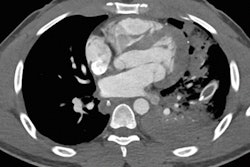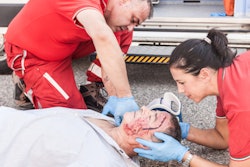
Doctors can safely forego CT imaging in more than one-third of emergency blunt trauma cases by using clinical criteria to assess patients rather than automatically sending them to imaging, according to a study of more than 11,000 patients that was published October 6 in PLOS Medicine.
The researchers hypothesized that two validated clinical tools could be used to avoid unnecessary radiation-bearing exams and also save money. They showed that nearly all injuries can be found using the two sets of clinical criteria, which they called "decision instruments," comprising either six or seven elements. Both deliver at most a small fraction of the radiation dose of CT, the group reported.
"CT scans deliver radiation dosages to the body that elevate cancer risk, especially in the young, and they are expensive, so we want to be sure to use them only when they are likely to provide a diagnostic benefit," said lead author Dr. Robert Rodriguez from the University of California, San Francisco (UCSF) in a statement.
The two sets of clinical criteria were designed with varying levels of sensitivity. Aside from a chest x-ray, all of the criteria were simple parts of a routine trauma history and physical exam that do not require extra provider time (PLOS Medicine, October 6, 2015).
The decision instruments were as follows:
- Chest CT-All: This protocol maximized sensitivity to detect all injuries. It consisted of seven criteria: abnormal chest x-ray, rapid deceleration mechanism, distracting injury, chest wall tenderness, sternal tenderness, thoracic spine tenderness, and scapular tenderness.
- Chest CT-Major: This protocol had high sensitivity to detect primarily major injuries that would require intervention. It included the above criteria, except for the rapid deceleration mechanism.
To test the validity of the criteria, the researchers enrolled 11,477 patients (mean age, 46 years; 61% men) who had presented with emergency blunt trauma injuries between 2001 and 2014. The subjects were divided into two groups: 6,002 were in the derivation or testing phase and 5,475 were in the validation phase.
| Accuracy of clinical criteria for assessing major chest injuries | ||
| Chest CT-All | Chest CT-Major | |
| Sensitivity | 99.2% | 99.2% |
| Specificity | 20.8% | 31.7% |
| Negative predictive value | 99.8% | 99.9% |
Either of the two approaches would have identified more than 99% of the major injuries in the study group, the authors determined. Using the Chest CT-All criteria would have found approximately 95% of all injuries and reduced the use of chest CT scans by about 25%. Meanwhile, the Chest CT-Major approach would have found approximately 90% of all injuries and enabled clinicians to forego chest CT in 37% of patients.
The decision instruments "consist of simple, readily available criteria that detect clinically significant thoracic and intrathoracic injury with very high sensitivity," the authors concluded.
As for limitations of the study, "some clinicians may disagree with our injury classification and sensitivity thresholds for injury detection," they wrote.
Critics may also express support for chest CT as part of a head-to-pelvis CT scan for major blunt trauma evaluation, which can identify serious widespread injury. However, the two decision instruments are aimed at the hemodynamically stable, less critically ill patient, they noted.




















